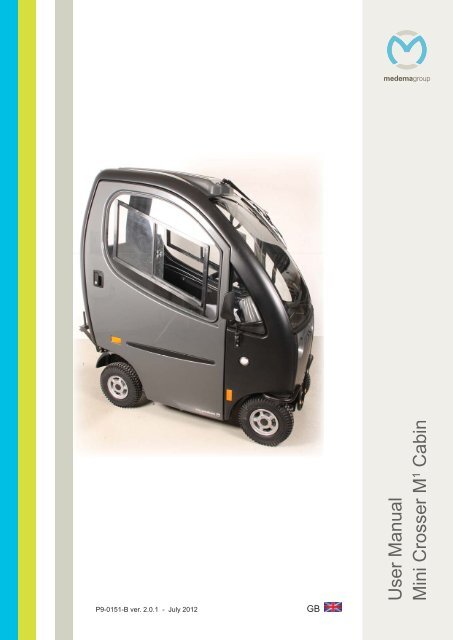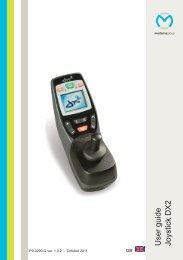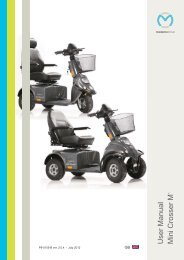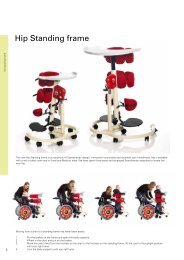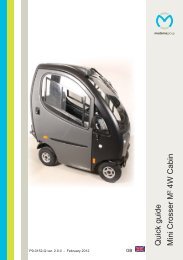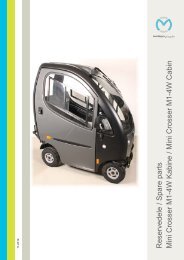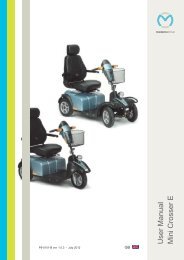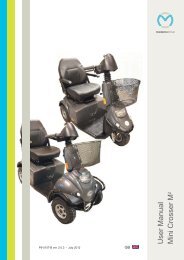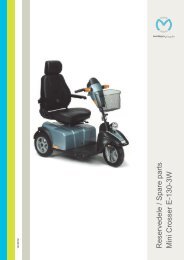M1 Cabin GB User manual - Mini Crosser
M1 Cabin GB User manual - Mini Crosser
M1 Cabin GB User manual - Mini Crosser
- No tags were found...
You also want an ePaper? Increase the reach of your titles
YUMPU automatically turns print PDFs into web optimized ePapers that Google loves.
medemagroupP9-0151-B ver. 2.0.1 - July 2012<strong>GB</strong><strong>User</strong> Manual<strong>Mini</strong> <strong>Crosser</strong> M 1 <strong>Cabin</strong>
Medema Production A/SContentsSymbols.................................................................................. 4Warning! ................................................................................. 4Contagion! .............................................................................. 4Introduction ............................................................................ 5Declaration of conformity ..................................................... 6Control panel ......................................................................... 7Preparations / Adjustments prior to use ............................. 10Seat rotation ........................................................................... 12Steering column .................................................................... 13Serial number......................................................................... 14Driving the <strong>Mini</strong> <strong>Crosser</strong> M 1 <strong>Cabin</strong> ....................................... 15Specific driving situations .................................................... 20Long hills/difficult ground .................................................... 22Anti-tilt wheels / stabilisers .................................................. 23General care and maintenance ............................................ 24Insurance................................................................................ 25Batteries ................................................................................. 26Charging ................................................................................. 26Battery disposal..................................................................... 28Storage ................................................................................... 28Cleaning ................................................................................. 28Fuel for heater........................................................................ 29Heater ..................................................................................... 29Windscreen wiper / washer .................................................. 30Replacing the wiper blade .................................................... 31Replacing the bulb - headlight ............................................. 31Changing the wheels ............................................................. 33Fuses ...................................................................................... 34Brakes..................................................................................... 36Disengagement ...................................................................... 37Transporting ........................................................................... 37Securing to vehicle floor with belts ..................................... 38Transporting by plane ........................................................... 40Towing .................................................................................... 40Dimensioned drawing, <strong>Mini</strong> <strong>Crosser</strong> M 1 <strong>Cabin</strong>..................... 41Introduction to seats - Ergo Standard ................................. 42Introduction to seats - Mando .............................................. 44Troubleshooting .................................................................... 45Programming ......................................................................... 47Technical data ........................................................................ 47International addresses ........................................................ 50<strong>User</strong> guide P9-0151-B 3 of 52 Version 2.0.1/2012
Medema Production A/SSymbolsUsed in the <strong>manual</strong> to indicate sections describing situationswhere extra care is required owing to the risk of personal injury.Used to indicate sections on electromagnetic compatibility(EMC).Warning!For safety reasons the vehicle must not be lent to persons whoare not completely familiar with it. The vehicle is designed forone person only.The <strong>Mini</strong> <strong>Crosser</strong> M 1 <strong>Cabin</strong> has been designed for usersweighing max. 175 kg. The vehicle can be specially adapted atthe factory for users weighing up to 200 kg.Contagion!Note!The tires can sometimes rub off on floor coverings, particularlylinoleum. Medema Production assumes no responsibility incase of contagion.To prevent this, we recommend that you protect delicate floorswith some sort of driving surface.<strong>User</strong> guide P9-0151-B 4 of 52 Version 2.0.1/2012
Medema Production A/SIntroductionCongratulations on your new <strong>Mini</strong> <strong>Crosser</strong> M 1 <strong>Cabin</strong> electricmobility scooter.You have now taken possession of an electric mobility scooterdeveloped for outdoor driving by active users. It is what iscalled a Class C vehicle in accordance with the Europeanclassifi cation of electric scooters.For optimum enjoyment of this vehicle - and to avoid breakdownsand accidents - we recommend that you read this <strong>User</strong> Manualcarefully. As a new user, you should pay particular attention tothe section entitled “Driving the <strong>Mini</strong> <strong>Crosser</strong> M 1 <strong>Cabin</strong>”.The <strong>Mini</strong> <strong>Crosser</strong> M 1 <strong>Cabin</strong> is designed for safe travel for at least10 years, up to a max. of 5,000 hours, provided it is serviced andsafety-checked every year, corresponding to 500 hours of operation.The service must be carried out by an authorised workshop.IMPORTANT! For safety reasons it is of the utmost importancethat service and safety check intervals are complied with, asthis minimises the risk of brake failure and short-circuits in thewiring, which could generate heat and cause a fire.We offer a wide range of accessories for the <strong>Mini</strong> <strong>Crosser</strong>M 1 <strong>Cabin</strong> that can make everyday life easier for you. You arealways welcome to contact us for further information on specialaccessories and adaptations.Medema Production A/S is not responsible for any damageor injuries caused by inappropriate or unsafe use of the <strong>Mini</strong><strong>Crosser</strong> M 1 <strong>Cabin</strong>.If you have any further questions about the <strong>Mini</strong> <strong>Crosser</strong> M 1<strong>Cabin</strong> or this <strong>User</strong> Manual, you are always welcome to get intouch. Our contact details are as follows:Medema Production A/STel: +45 7010 2054Email: info@minicrosser.comInternet: www.minicrosser.dkNB: Errors and omissions excepted. We reserve the right toupdate this <strong>manual</strong> as required.<strong>User</strong> guide P9-0151-B 5 of 52 Version 2.0.1/2012
Medema Production A/SDeclaration of conformityMedema Production A/S hereby declares that:Machine:Use:Model No:<strong>Mini</strong> <strong>Crosser</strong>(Prescribed use in<strong>User</strong> Manual)M 1 <strong>Cabin</strong>Complies with the Medical Device Directive 93/42/EECThe product is made in accordance with the harmonizedstandard EN 12184 - Electrically powered wheelchairs, scootersand their chargers.The product is risk analysed in accordance with the harmonizedstandard DS/EN ISO 14971:2007-04-10 2. edition - Medicaldevices - Application of risk management to medical devices.The <strong>Mini</strong> <strong>Crosser</strong> can, for a fee, be taken to the nearestdealer for disposal in accordance with current environmentalregulations.Manufacturer:Address:<strong>Mini</strong> <strong>Crosser</strong> A/SEnggårdvej 7, DK-7400 HerningTel./Fax +45 7010 2054 +45 9716 8582Date: 12.04.2010Signature: _____________________<strong>User</strong> guide P9-0151-B 6 of 52 Version 2.0.1/2012
Medema Production A/SControl panelAvoid subjecting the control panel to jarring and knocks. Takecare when driving and avoid hitting obstacles.The manufacturer accepts no liability in respect of theunauthorised opening, adjustment or modification of the controlpanel.Battery indicatorLight switchHandbrakeHazard warning lightsSpeed selectorIndicator lights, R/LIndicator lights,R/LHornHornAccelerator(four-fi nger control)Lever for adjusting the angle of thehandlebarsCharging socketKey switch<strong>User</strong> guide P9-0151-B 7 of 52 Version 2.0.1/2012
Medema Production A/SAir channelWindscreen wiper + washerFresh-air/hot-air switchHeat regulationAccelerator(four-fi nger control)<strong>User</strong> guide P9-0151-B 8 of 52 Version 2.0.1/2012
Medema Production A/SPreparations / Adjustments prior to useAdjusting the height of the seatLift the seat off. Pull the release out and adjust the seat tube tothe desired position. See the picture on the next page. Checkthat the seat height is correct and let go of the release. Movethe seat tube up/down until the release clicks into a hole.Make sure you keep your back straight when lifting the seat,which is very heavy. (See below.)Lift the seat off the seat tube.The resease button pressed in. Pressthe button out to release the seat tube.Resease button pressed out. Now theseat tube can be moved up/down to thehight you wish. Press the release buttonagain and make sure it is fi tted in one ofthe 5 holes in the seat tube.<strong>User</strong> guide P9-0151-B 10 of 52 Version 2.0.1/2012
Medema Production A/SSeat tubeReleaseSeat tube in top position. There are fi veholes for adjusting the seat tube. Therelease must be in a hole for the seat tobe stable.<strong>User</strong> guide P9-0151-B 11 of 52 Version 2.0.1/2012
Medema Production A/SSeat rotationIt is only possible to rotate the seat in a <strong>Mini</strong> <strong>Crosser</strong> with <strong>Cabin</strong>if both dors are open.Pull the release lever back. The seat can be rotated 90° toeither side. When the lever is released, it engages with the seatand holds it in place at 45° intervals.Other seats that can be supplied for the <strong>Mini</strong> <strong>Crosser</strong> work onsimilar principles. The release lever is normally mounted on theright, but can be put on the left if so wished.IMPORTANT!The <strong>Mini</strong> <strong>Crosser</strong> is most stable when the seat is in its lowestposition.Take extra care when lowering the seat on a <strong>Mini</strong> <strong>Crosser</strong> usingelectric seat adjustment. Make sure that nothing is trapped inthe space between the seat and the chassis.121. Release lever for seat rotation.2. Release lever for seat forward/back.Avoid trapping anything whenlowering the seat.<strong>User</strong> guide P9-0151-B 12 of 52 Version 2.0.1/2012
Medema Production A/SSteering columnCan be adjusted forward/back with the release lever. Pull downon the lever and pull the handlebars closer for a good drivingposition. Use the lever again and push the steering columnforward to make it easier to get out.The height of the steering column can be adjusted approx. 11cm up/down. First remove the rubber plug covering the Allenscrew. Adjust the height using a 4 mm Allen key.Adjusting the height ofthe handlebars.Lever for adjusting the angle ofthe handlebarsAdjusting the height ofthe handlebars.Allen screw for heightadjustment<strong>User</strong> guide P9-0151-B 13 of 52 Version 2.0.1/2012
Medema Production A/SDriving the <strong>Mini</strong> <strong>Crosser</strong> M 1 <strong>Cabin</strong>Getting in and outIt is important to learn a safe technique for getting in and out ofthe <strong>Mini</strong> <strong>Crosser</strong>.In general the following method should be followed:• Make sure that the <strong>Mini</strong> <strong>Crosser</strong> M 1 <strong>Cabin</strong> is off (switch turned to0) when getting in and out, otherwise the <strong>Mini</strong> <strong>Crosser</strong> could startif the accelerator was touched inadvertently.• Make sure that the brake is on. (Lever for disengaging motor intop position.)• Put the steering column in vertical position.• If necessary, raise the armrest.Note! - Do NOT use the dors as support, when entering orgetting out of the vehicle.For some users the assistance of an attendant can berecommended. The attendant should:• Take care not to injure him/herself when lifting/lowering/supportingthe user.• Make sure that the <strong>Mini</strong> <strong>Crosser</strong> is stable and unable to move.Turn off the <strong>Mini</strong> <strong>Crosser</strong> and check that the brake is on.• Make sure that the seat the user is being moved to is stable.IMPORTANT!The <strong>Mini</strong> <strong>Crosser</strong> will turn itselfoff automatically after it hasbeen stationary for 10 minuteseven if the key has beenturned to driving position.To restart the vehicle, thekey must be turned to stopposition (0) and then to drivingposition (1).Turn the <strong>Mini</strong> <strong>Crosser</strong> off, return thesteering column to upright position andraise the armrest.<strong>User</strong> guide P9-0151-B 15 of 52 Version 2.0.1/2012
Medema Production A/SBraking systemsThere are three braking systems on the <strong>Mini</strong> <strong>Crosser</strong> M 1 <strong>Cabin</strong>:• Motor brake - adjusts vehicle speed also when going downhill.• Magnetic brake - the magnetic brake is automatic and engageswhen the <strong>Mini</strong> <strong>Crosser</strong> stops. In an emergency, the <strong>Mini</strong><strong>Crosser</strong> can be stopped instantaneously by turning the keyswitch. Please note that this will cause very sharp braking. Therear wheels will lock.Must NOT be used in the normal course of driving.The brake must never be disengaged mechanically using thedisengagement lever on a slope. This function is only designedfor use when pushing the <strong>Mini</strong> <strong>Crosser</strong> on a flat road.• Electric safety brake - if the brake is somehow disengaged ona slope/hill, the <strong>Mini</strong> <strong>Crosser</strong> will brake automatically when itreaches a certain speed. There is an electric safety feature in thecontrol system, which works even if the battery is disconnected.This is also the reason why the <strong>Mini</strong> <strong>Crosser</strong> cannot be towed atmore than 5 km/h. See the section about towing.• Handbrake - intended as an emergency brake and parkingbrake. It must be operated with caution when driving inslippery conditions and downhill.When using the handbrake as a parkingbrake, lock it in braking position bypressing the button in while applying thebrake.To release the brake, press the buttonagain.Handbrake lockGeneral safety adviceMake sure that the backrest is upright and the seat is as low aspossible.Positioning belts are recommended if the user is unable tomaintain a good driving posture independently.Adjust your driving to road conditions. Take account of light,<strong>User</strong> guide P9-0151-B 16 of 52 Version 2.0.1/2012
Medema Production A/Straffi c and weather. Be particularly careful when driving in thedark or in bad weather, such as rain or snow. Avoid driving ongradients with poor surfaces, such as: snow, ice, new-mowngrass, wet grass and wet leaves.Never drive when under the influence. This applies not only toalcohol, but also to drugs and medicines.Reduce speed immediately if you feel you are losing control.Always use the indicators when changing direction.Check that lights and indicators are working before driving off.Use your lights when driving after lighting-up time.As far as possible, grip the handlebars firmly with both hands.Take care not to have anything in the basket at the front thatmight inadvertently operate the accelerator.WARNING! Do not lower the handlebars so far that theaccelerator can hit you on the leg when you turn the vehicle andso be operated in advertently. If the handlebars need to be verylow, a twist grip accelerator is recommended. This is particularlyrelevant if leg supports are being used.ALWAYS switch the scooter off when it is not in use. Turn thekey to 0.DrivingEven though the <strong>Mini</strong> <strong>Crosser</strong> is very stable, it can tip over.Avoid sudden changes of speed and direction when travelling athigh speed, on poor surfaces and, not least, on slopes.For short distances the <strong>Mini</strong> <strong>Crosser</strong> can drive up steepergradients than it has been tested as dynamically stable for. Thesame applies to driving down such gradients. In such casesthere is an increased risk of the <strong>Mini</strong> <strong>Crosser</strong> tilting and eventipping over. So be extra careful in following the driving tipsgiven below.Anti-tilt wheels are recommended for driving in very hilly terrain.(Optional extra)<strong>User</strong> guide P9-0151-B 17 of 52 Version 2.0.1/2012
Medema Production A/SNew users are urged to practise the following in an area wherethere is no other traffic:• Set the <strong>Mini</strong> <strong>Crosser</strong> to low speed. Drive forwards and backwards.Gradually turn the speed selector up and feel the change in thespeed of the <strong>Mini</strong> <strong>Crosser</strong>.• Practise starting and braking. Get used to the <strong>Mini</strong> <strong>Crosser</strong>’sresponse time.• Practise driving in a narrow space, similar to inside a shop orthrough a door.• Practise turning, and get a sense of how much space is required.Always drive slowly when turning. Practise reversing too.• Practise cornering and driving over obstacles and on slopes.Always drive straight up/down kerbs and ramps. Never at anangle. See the illustrations on the following pages.• Try braking at different speeds and notice the stopping distances.• If possible, try driving on different surfaces (road, grass and gravel).• Practise assessing how far you can drive on a single batterycharge. Note how quickly the battery indicator changes fromgreen to amber to red.Note!The driving distance of the scooter will be reduced when drivingin hilly districts, into a head wind, in cold weather and with lowtyre pressure.Traffic regulationsThe traffi c legislation for scooters varies from country to country.Before starting to use the vehicle outdoors, it is the user’sresponsibility to familiarise him/herself with the relevant legislation.The following rules apply in Denmark:Mobility vehicles such as the <strong>Mini</strong> <strong>Crosser</strong> with a maximumspeed of up to 15 km/h count as cycles in traffic legislation andthe traffi c regulations for cycles must be followed at speeds inexcess of 6 km/h.At speeds of up to 6 km/h the <strong>Mini</strong> <strong>Crosser</strong> is regarded as a“pedestrian”, and it is permissible to travel on the pavement at<strong>User</strong> guide P9-0151-B 18 of 52 Version 2.0.1/2012
Medema Production A/Sthis speed. “Tortoise” speed corresponds to approx. 6 km/h.Lights must only be used during lighting-up time. Crash helmetand seat belts are not compulsory.Electromagnetic compatibilityIf the <strong>Mini</strong> <strong>Crosser</strong> starts making involuntary movements or ifthe brakes are released, turn the <strong>Mini</strong> <strong>Crosser</strong> off as soon as itis safe to do so. In certain circumstances a <strong>Mini</strong> <strong>Crosser</strong> can setoff shop alarms.The <strong>Mini</strong> <strong>Crosser</strong> satisfies the requirements for the use of scootersin an environment with electromagnetic noise. There may,however, be rare situations in which electromagnetic noise canaffect the <strong>Mini</strong> <strong>Crosser</strong>. Sources of such noise include radio andtelevision stations, amateur radio transmitters and mobile phones.If such equipment is being used close by, it is recommendedthat the <strong>Mini</strong> <strong>Crosser</strong> is switched off. Mobile phones should notbe used while driving.When driving in traffic...Be particularly aware of the following when driving in traffic:• The <strong>Mini</strong> <strong>Crosser</strong> is a low vehicle and not always easy for otherroad users to see. Make quite sure that other road users haveseen you before driving onto the highway.• Be aware of the blind spots and look around them beforechanging direction.• Keep an eye on traffic behind you. Keep well over to the side ofthe road when driving on busy roads.• Turning right and left at crossroads. Be aware of cyclists andpedestrians. Follow the rules of the road for cyclists.• How quickly things are happening. How long do the lights staygreen? How quickly are cars approaching? etc.<strong>User</strong> guide P9-0151-B 19 of 52 Version 2.0.1/2012
Medema Production A/SSpecific driving situationsUp kerbs• Stop at right angles to the kerbstone about 5-10 cm away from it.Keep an eye on other road users.• Lean forwards.• Accelerate moderately so that your vehicle can overcome the obstacle.Do not stop halfway, but reduce speed once the vehicle is up.• If the kerb is too high, do not try again, but find an alternativeroute.Down kerbs• Lean back.• If you are driving onto a road with traffic, keep an eye on otherroad users.• Drive forwards and down the kerb at low speed. Make sure thatyour anti-tilt wheels (if fitted) do not catch on the edge.<strong>User</strong> guide P9-0151-B 20 of 52 Version 2.0.1/2012
Medema Production A/SUp a ramp/hill• There is a risk of tipping over backwards if the seat is pushedback when you start driving up a slope, e.g. a ramp.• Pull the seat forward! Check that any ramp is stable.• Lean forwards.• Accelerate moderately so that your vehicle can overcome theobstacle. Do not stop halfway. Reduce speed once the vehicle isup. If you need to start on a hill, accelerate slowly so as not to tipover backwards.Down a ramp/hill• Check that any ramp is stable.• Lean back.• Drive slowly down. Avoid stopping midway on short, steep slopes.On long hills, it is advisable to stop every now and again if youfeel your speed is getting too high.<strong>User</strong> guide P9-0151-B 21 of 52 Version 2.0.1/2012
Medema Production A/SAcross a slope• Lean into the slope.• Avoid sudden and sharp movements. This is particularly relevantwhen reversing.• Always drive at low speed.Long hills/difficult groundThe <strong>Mini</strong> <strong>Crosser</strong> M 1 <strong>Cabin</strong> is at risk of overheating on very longand steep hills or on very soft ground, possibly also combinedwith high user weight.To protect the <strong>Mini</strong> <strong>Crosser</strong> motor from overheating, there is abuilt-in thermoswitch, which initially sets the <strong>Mini</strong> <strong>Crosser</strong> to halfspeed.However, if you carry on moving over diffi cult ground, the <strong>Mini</strong><strong>Crosser</strong> will at some stage stop completely, and the batteryindicator will flash with 6 lamps. The <strong>Mini</strong> <strong>Crosser</strong> must be leftto cool down for 3-5 minutes before it can start again.To reset the fault, switch off the <strong>Mini</strong> <strong>Crosser</strong> then turn it onagain.If the <strong>Mini</strong> <strong>Crosser</strong> has not had long enough to cool down whenit is restarted, it will initially only run at half speed.Note:The situation described above will never happen in normal use.It only happens if the conditions are extremely challenging.<strong>User</strong> guide P9-0151-B 22 of 52 Version 2.0.1/2012
Medema Production A/SAnti-tilt wheels / stabilisersThe <strong>Mini</strong> <strong>Crosser</strong> M 1 <strong>Cabin</strong> is a very stable vehicle. HOWEVER,in the case of incorrect weight distribution or careless drivingthere is a risk of tipping over.We therefore recommend fitting anti-tilt wheels in suchcircumstances. (See picture below)(Anti-tilt wheels / stabilisers are optional extras.)Anti-tilt wheels<strong>User</strong> guide P9-0151-B 23 of 52 Version 2.0.1/2012
Medema Production A/SGeneral care and maintenanceA <strong>Mini</strong> <strong>Crosser</strong> M 1 <strong>Cabin</strong> does not require much maintenance.It should be kept in a generally good condition, however. Thefollowing should be checked regularly:• Tyre pressure (if pneumatic tyres are fitted)• Tyre wear• Keep the control panel, the charging socket and the electronicsbox under the seat dry.• Battery chargingNever wash the <strong>Mini</strong> <strong>Crosser</strong> with a high-pressure cleaner ordirect water jet! This could damage the <strong>Mini</strong> <strong>Crosser</strong>’s electronics.To keep the <strong>Mini</strong> <strong>Crosser</strong> in good condition safety-wise, werecommend the following regular checks:Daily:• Test the indicators and driving lights before using the <strong>Mini</strong> <strong>Crosser</strong>in the dark or poor visibility.Every three months:Test the brakes and motor disengagementWith the disengagement lever up, it must not be possible topush the <strong>Mini</strong> <strong>Crosser</strong>.Test the brake disengagement functionWhen the brake disengagement lever is down, the batteryindicator should flash to show an error if the <strong>Mini</strong> <strong>Crosser</strong> isturned on. In this case the <strong>Mini</strong> <strong>Crosser</strong> must not be able tomove when the accelerator is activated.Test the handbrake.Apply the handbrake for a couple of seconds at low speed. Thiswill ensure that the lever arm and brake shoes do not seize up.Lubricate the lever arm on the brake hub with acid-free oil - lefthandrear wheel.Test the windscreen wiper.Spray washer fluid on the window and check that the wiperblade works properly.<strong>User</strong> guide P9-0151-B 24 of 52 Version 2.0.1/2012
Medema Production A/SAnnualThe <strong>Mini</strong> <strong>Crosser</strong> M 1 <strong>Cabin</strong> is designed for safe travel for atleast 10 years, up to a max. of 5,000 hours, provided it isserviced and safety-checked every year, corresponding to500 hours of operation. The service must be carried out by anauthorised workshop.IMPORTANT! For safety reasons it is of the utmost importancethat the servicing and safety check intervals are complied with,as this minimises the risk of brake failure and short-circuits inthe wiring, which could generate heat and cause a fire.(For further information see the Service Manual.)InsuranceIn the eyes of the law a <strong>Mini</strong> <strong>Crosser</strong> M 1 <strong>Cabin</strong> with a maximumspeed of 15 km/h is a cycle, so separate insurance is notrequired.Most contents/home insurance policies include third-partyliability insurance for cyclists and so also cover <strong>Mini</strong> <strong>Crosser</strong> M 1<strong>Cabin</strong> users.We recommend that you talk to your insurance company aboutthis when the vehicle is delivered. If necessary, comprehensiveinsurance will have to be taken out separately.<strong>User</strong> guide P9-0151-B 25 of 52 Version 2.0.1/2012
Medema Production A/SBatteriesThe <strong>Mini</strong> <strong>Crosser</strong> uses sealed, maintenance-free GEL batteries(Exide 12 V/56 Ah or AGM 12 V/75 Ah).They do not generate gas and do not have to be topped up withwater.ChargingPlease NOTE that the <strong>Mini</strong> <strong>Crosser</strong> can be equipped withseveral types of charger (ask your dealer for information on thevarious types).IMPORTANT! Only ever use a charger designed for charging drymaintenance-free batteries. The max. charging current is 12 A.If charging is to take place outdoors, an enclosed chargerwithout a fan should be chosen.The battery manufacturer recommends charging the batteries attemperatures between +10° and +30°C in order to achieve thecharging times specified in “Technical data”.Charging will take longer at temperatures below +20°C. This isbecause the battery finds it more difficult chemically to absorbthe current.Please NOTE that the capacity of the batteries will reduceover time and at low temperatures. In practice this means thatvehicles with old batteries have a shorter driving distance thanthey had when the batteries were new.Battery capacity at -10°C is about half the equivalent capacity at+20°C.Avoid draining the batteries completely. We recommendcharging the batteries in a heated room. If it is not possible todo this every day, it is a good idea to charge the <strong>Mini</strong> <strong>Crosser</strong> ina heated room (approx. 20°C) once a week.<strong>User</strong> guide P9-0151-B 26 of 52 Version 2.0.1/2012
Medema Production A/SNew batteries do not reach full capacity until they have beencharged and discharged about 20 times.It is IMPORTANT to fit the batteries correctly. The batteryterminals and snap locks are marked +/-. They must be fittedas shown in the sketch below. Make sure that the snap locksare properly closed. For the same reason there must not be anyburrs on the terminals.The <strong>Mini</strong> <strong>Crosser</strong> should be charged while not in use. Thecharger supplied from the factory switches over to tricklecharging (very low power consumption) automatically when thebatteries are fully charged. You can therefore leave the chargerconnected until the <strong>Mini</strong> <strong>Crosser</strong> is next used. The chargercannot overcharge the batteries.The charger will flash until charging is complete. Then it willshow a steady light.The charger must not be placed on the seat during charging.IMPORTANT! Never use charging devices other than thosesupplied from the factory without first contacting the dealer.NEUTRIK NC3MX charging plugConnect the charging plug to the 3-pinsocket on the steering column. Thecharging socket is located under theprotective cover.<strong>User</strong> guide P9-0151-B 27 of 52 Version 2.0.1/2012
Medema Production A/SBattery disposalUsed batteries must be disposed of through your supplier or ata recycling centre.Take care when handling leaky batteries, as the gel containscorrosive acid.INFO!New batteries can be purchased from Medema Danmark A/S.StorageThe scooter should be stored and charged under cover,preferably at temperatures above 0°C.Note!The charger must be kept dry, but should not be covered whenin use.In the case of long-term storage we recommend covering the<strong>Mini</strong> <strong>Crosser</strong> M 1 <strong>Cabin</strong> to protect it from dust, rain and sunlight.CleaningClean the <strong>Mini</strong> <strong>Crosser</strong> M 1 <strong>Cabin</strong> with ordinary autoshampoo. Ifnecessary, wipe dry with a chamois leather.Wipe the covers dry and polish with car wax.Rinse with a garden hose with a soft jet.IMPORTANT! Never use a high-pressure cleaner or hose, as itcould damage the <strong>Mini</strong> <strong>Crosser</strong>’s electronics.<strong>User</strong> guide P9-0151-B 28 of 52 Version 2.0.1/2012
Medema Production A/SFuel for heaterThe tank for fuel is placed behind the seat, and filled from theoutside.Use ONLY paraffin or diesel.In the front, right side of the<strong>Mini</strong> <strong>Crosser</strong> M 1 <strong>Cabin</strong>, youfi nd the the exhaustion fromthe heater.NOTE! It gets VERY hot.Exhaustion from heater.HeaterKnob to:- turn heater on/off- ajusting the temperature- remove fault code.Indicator light for on/off andfault code readout.For more information: seeWebasto user guide.<strong>User</strong> guide P9-0151-B 29 of 52 Version 2.0.1/2012
Medema Production A/SIMPORTANT!The heating ribs by the windowand by the legs should NOT becovered up when the heating ison. That will cause overheatingof the heaterWindscreen wiper / washerStart the windscreen wiper byturning this knob.Notice the smooth speedajusting.Windscreen wiper - turn the knob.Washer - press this buttonThe Container for washerfl uid is placed under the frontcover.The container for the washer fluid.<strong>User</strong> guide P9-0151-B 30 of 52 Version 2.0.1/2012
Medema Production A/SReplacing the wiper bladeTo exchange the wiper blade,do the following:Screw this screw out.Lift carefully, so you can pullthe wiper blade over the pin.Mount a new in reverseorder.Replacing the bulb - headlightOpen the front cover, byturning the handle 90°counter clockwise, and pull.Remove the protective cap.<strong>User</strong> guide P9-0151-B 31 of 52 Version 2.0.1/2012
Medema Production A/SPress down and turn counterclockwise.-and lift out.Now you have access to thebulb.take the bulb out.Mount a new in reverseorder.NOTE!Be aware that drain list arenot trapped when the frontcover is closed.It MUST cover the edge ofthe front cover.<strong>User</strong> guide P9-0151-B 32 of 52 Version 2.0.1/2012
Medema Production A/SChanging the wheelsIf you get a puncture in one of the pneumatic tyres or if atyre is so badly worn that it needs to be replaced, follow theinstructions below.Tyres and inner tubes can be purchased from the authoriseddealer who supplied the <strong>Mini</strong> <strong>Crosser</strong>.The <strong>Mini</strong> <strong>Crosser</strong> must be TURNED OFF before you start.Changing the wheels5 mm Allen key• Undo the five bolts.• Take the wheel off.• When the wheel is putback on, the springwashers must be refittedbetween the wheel rimand bolts.REMEMBER!• to let all the air out before takingthe wheel apart to repair apuncture• to secure the bolts with springwashersThe bolts must be doneup tightly.<strong>User</strong> guide P9-0151-B 33 of 52 Version 2.0.1/2012
Medema Production A/SFusesThe <strong>Mini</strong> <strong>Crosser</strong> M 1 <strong>Cabin</strong> has the following protectionsystems:• Automatic overload protection, which limits the current to themotor. This protection is integral to the control system and cannotbe adjusted. It prevents both the control system and the motorfrom being overloaded. In the event of overload the current to themotor is reduced - full speed and traction can be resumed afterthe motor has cooled down for 2-5 minutes.• The control fuse protects against mains faults. It is located underthe rear cover.• The main fuse protects against short-circuits in the main currentcircuit. The fuses are located under the rear cover behind thebatteries. Fuse type DIN 2581.• If the ignition key is turned at the same time as the accelerator isoperated, the vehicle will not move off for safety reasons.• The lights and horn are protected by electronic fuses, whichprotect against any short-circuiting that may occur. To preventaccidental short-circuiting when a bulb is changed, the <strong>Mini</strong><strong>Crosser</strong> must be turned off when the new bulb is fi tted and thenturned on again afterwards.Take the rear cover off. The plastic cover can be removed by squeezing the sides.Now the fuses can be replaced.<strong>User</strong> guide P9-0151-B 34 of 52 Version 2.0.1/2012
Medema Production A/SOpen the front cover, byturning the handle 90°counter clockwise, and pull.Under the front cover you willfind the fuse for the heaterand windscreem wiper.Fuse for windscreen wiper.Fuse for heater.NOTE!Be aware that drain list arenot trapped when the frontcover is closed.It MUST cover the edge ofthe front cover.<strong>User</strong> guide P9-0151-B 35 of 52 Version 2.0.1/2012
Medema Production A/SBrakesThere are three braking systems on the <strong>Mini</strong> <strong>Crosser</strong> M 1 <strong>Cabin</strong>:• Motor brake• Magnetic brake• Handbrake• Motor brake: adjusts vehicle speed also when going downhill.• Magnetic brake - the magnetic brake is automatic and engageswhen the <strong>Mini</strong> <strong>Crosser</strong> stops. In an emergency, the <strong>Mini</strong><strong>Crosser</strong> can be stopped instantaneously by turning the keyswitch. Please note that this will cause very sharp braking. Therear wheels will lock.Must NOT be used in the normal course of driving.The brake must never be disengaged mechanically using thedisengagement lever on a slope. This function is only designedfor use when pushing the <strong>Mini</strong> <strong>Crosser</strong> on a flat road.• Electric safety brake - if the brake is somehow disengaged ona slope/hill, the <strong>Mini</strong> <strong>Crosser</strong> will brake automatically when itreaches a certain speed. There is an electric safety feature in thecontrol system, which works even if the battery is disconnected.This is also the reason why the <strong>Mini</strong> <strong>Crosser</strong> cannot be towed atmore than 5 km/h. See the section about towing.• Handbrake: intended as an emergency brake and parkingbrake. It must be operated with caution when driving in slipperyconditions and downhill.<strong>User</strong> guide P9-0151-B 36 of 52 Version 2.0.1/2012
Medema Production A/SDisengagement• Turn the key to (0) position.• Push the disengagement lever at the back down.The motor brake is now disengaged and the vehicle can bepushed or towed, but not driven.NOTE!The motor brake must never be disengaged on sloping terrain.Once the motor brake has been disengaged, the <strong>Mini</strong><strong>Crosser</strong> can only be braked with the hand brake.Push the disengagement lever down todisengage (only handbrake works) andpush up to reactivate the motor (normaldriving now possible).Disengagement leverTransportingThe <strong>Mini</strong> <strong>Crosser</strong> m 1 <strong>Cabin</strong> must always be restrained and thehandbrake locked during transport.Avoid lifting by the covers.If you just need to lift the scooter slightly, take hold of the rearbumper and the front bumper.Secure it in the vehicle with belts attached to the two eyes atthe front and two at the back. All the eyes are marked in yellow.See the section entitled “Securing to vehicle floor with belts”.<strong>User</strong> guide P9-0151-B 37 of 52 Version 2.0.1/2012
Medema Production A/SSecuring to vehicle floor with beltsDahl Engineering belt set for securing in motor vehicles.Item No. C2-0242ALWAYS use four belts at the back and two at the front.The belts must always be attached to approved fittings in thevehicle and the four eyes welded to the scooter.The belts MUST be attached within the angles shown in thepicture for optimum security.45˚45˚<strong>User</strong> guide P9-0151-B 38 of 52 Version 2.0.1/2012
Medema Production A/SAttachment pointGreater thanthe anchoragepoints on thescooterCentre lineAttachment pointGreater thanthe anchoragepoints on thescooter<strong>User</strong> guide P9-0151-B 39 of 52 Version 2.0.1/2012
Medema Production A/STransporting by planeIf the <strong>Mini</strong> <strong>Crosser</strong> is to be transported by plane, the airlinesrequire:• the batteries to be flight-approved• the air to be let out of the tyres• the battery leads to be disconnected (not always, but frequently)The seat and cover have to be removed to disconnect thebattery leads.A battery declaration for air travel can be found on the <strong>Mini</strong><strong>Crosser</strong> website:http://www.minicrosser.dk/Download_brochurer.aspTowingIf you should be unfortunate enough to break down, the <strong>Mini</strong><strong>Crosser</strong> can be towed or pushed. The <strong>Mini</strong> <strong>Crosser</strong> mustalways be turned off and the motor brake disengaged duringtowing. See the section on Brakes.If the <strong>Mini</strong> <strong>Crosser</strong> is to be towed, secure a rope to the towfi tting on the front - marked with a yellow “hook mark”. Do nottow faster than 5 km/h. The scooter will generate electricitywhen it is towed, with the motor acting as a dynamo. If itis towed at more than 5 km/h, there is a risk of the motorgenerating enough electricity to damage the scooter and, in theworst case, cause a fire.The <strong>Mini</strong> <strong>Crosser</strong> M 1 <strong>Cabin</strong> will atempt to brake, if it is towedfaster than 5 km/h.<strong>User</strong> guide P9-0151-B 40 of 52 Version 2.0.1/2012
Medema Production A/SDimensioned drawing, <strong>Mini</strong> <strong>Crosser</strong> M 1 <strong>Cabin</strong>175 mm1600 mm1610 mm1030 mm730 mm1050 mm<strong>User</strong> guide P9-0151-B 41 of 52 Version 2.0.1/2012
Medema Production A/SIntroduction to seats - Ergo StandardLever for seat rotationPull the lever back to releasethe seat. The seat can then beturned 90° to either side with astop every 45°.The lever is spring-loaded and the seat locks automaticallywhen the lever is released.This lever is located on the right as standard, but can also beput on the left.Lever for seat forward/backPull the lever out/up to releasethe seat on the slide rail.The seat can then be movedforward or back as required.When the lever is released, the seat automatically locks at thenearest stop.There is a chock block on the front and back of the slide rail.Adjusting the angle of thearmrestThe adjusting screw makes itpossible to alter the angle ofthe armrest by about 15°.The arm can be folded rightup to make it easier to get inand out.(Height adjustment of thearmrest is an optional extra.)<strong>User</strong> guide P9-0151-B 42 of 52 Version 2.0.1/2012
Medema Production A/SAdjusting the angle of thebackrestThe angle of the backrest canbe adjusted by about 30°. Thiscan be done by undoing theadjusting screw and changingthe position of the spacer.Do the screw up again aftermaking the adjustment.Optional extra:The seat can be fitted with agas cylinder for adjusting theangle of the backrest.Armrest forward / back:The armrest can be movedforward / back on the C-rail.This can be done by undoingthe screws indicated. Do thescrews up again after makingthe adjustment.Backrest forward / back:The depth of the seat can beadjusted. This can be done bymoving the backrest forwardand back while the seatcushion is held in position.Undo the screws indicated onboth sides. The backrest canthen be moved as far back as the edge of the rail and about 15cm forward. Do the screws up after making the adjustment. Thescrews must be at least 2 cm from the end of the C-rail.<strong>User</strong> guide P9-0151-B 43 of 52 Version 2.0.1/2012
Medema Production A/SIntroduction to seats - MandoAdjusting the angle of thebackrest:The angle of the backrest canbe adjusted by about 30° byraising this lever.Adjusting the angle of thearmrest:The angle of the armrest canbe adjusted by turning thisscrew.Adjusting the height of thearmrest:The armrest can be raised/lowered by undoing thetwo screws and moving thebracket one hole up or down.Headrest:The headrest can be raisedand lowered steplessly.<strong>User</strong> guide P9-0151-B 44 of 52 Version 2.0.1/2012
Medema Production A/STroubleshootingThe following is a list of various problems that, in ourexperience, may occur. The list gives possible causes andremedies.Problem Possible causes RemedyThe <strong>Mini</strong> <strong>Crosser</strong> will notgo.The battery indicator isnot lit.The <strong>Mini</strong> <strong>Crosser</strong> willnot go, but the batteryindicator is lit.The driving speed is toolow.The driving distance percharge is too short.The charging lamp onthe charger does not lightup when the charger isconnected to the mainsand the <strong>Mini</strong> <strong>Crosser</strong>.The “ready” lamp on thecharger does not light upeven though the chargerhas been on for 10-12hours.The key has not beenturned to start.The batteries arecompletely fl at.The control fuse has blown.The main fuses have blown.The <strong>Mini</strong> <strong>Crosser</strong> hasbeen overloaded.The handbrake is on.There is a fault in theelectronics.The batteries are fl at.The charging plug has notbeen removed.The speed selector is onslow.The electronics areoverloaded.There is too little air in thetyres.There is a problem withthe batteries.Low temperature.There is a problem withthe charger.There is too little air in thetyres.The charging method iswrong.No power to the switch.Fault in cable.Fault in charger.There has been a powercut.The charger is doing atop-up charge.There is a problem withthe batteries.There is a fault in thecharging plug for the <strong>Mini</strong><strong>Crosser</strong> M 1 .Turn the key and wait 5sec. before activating theaccelerator.Charge the batteries.Change the fuse.Contact supplier.Wait approx. 1 min. beforetrying again. The vehiclemust be turned off (seesection on Fuses).Release the handbrake.Contact supplier.Contact supplier.Remove the chargingplug.Change to a faster speed.Stop and wait a fewseconds before starting.Pump the tyres up to theright pressure.Charge the batteries andcheck that the green lampon the charger lights upbefore driving off.Contact supplier.Pump the tyres up to theright pressure.Read the section onCharging in the <strong>User</strong> Manual.Turn the switch on.Contact supplier.Read the operatinginstructions for the charger.Contact supplier.Reconnect the chargerand repeat the chargingprocess.Check again half an hourlater.Contact supplier.Push the charging plug allthe way in and repeat thecharging process. Readthe operating instructionsfor the charger.<strong>User</strong> guide P9-0151-B 45 of 52 Version 2.0.1/2012
Medema Production A/SProblem Possible causes RemedyThe “ready” lamp on thecharger lights up evenwhen partly dischargedbatteries are connected.The charger lamp isshowing an error.The heater doesn’t work.The washer doesn’t work.The windscreen wiperdoesn’t work.The fuse in the chargerhas blown.The switch in the chargingplug is malfunctioning.The charging plug has notbeen inserted or there is amains fault.The battery voltage is toolow for charging to start.Need paraffi n/diesel.The fuse has blownWasher fl uid i missing.The fuse has blown.The fuse has blown.Contact supplier.Contact suppliers - readthe operating instructionsfor the charger.Push the charger plug inor contact the supplier.Read the operatinginstructions for the charger- or contact the supplier.Put on paraffin og diesel.Change the fuse.Read the Webasto userguide for more information.Put on washer fluid.Change the fuse.Change the fuse.If there is an electronic fault, a number of lamps in the batteryindicator will light up. The following table shows what theymean.Lamps Causes Remedy1 lamp The batteries need chargingor the connection to a batteryis poor.Check all connections betweenthe controller and batteries. Ifthese are fi ne, try charging thebatteries2 lamps Poor connection to the motor. Check the connection betweenthe motor and controller. Contactsupplier.3 lamps Short-circuit betweenthe motor and a batteryconnection.4 lamps Not in use5 lamps Not in use6 lamps The S180 is prevented fromdriving. Inhibit 2 is active. Thismay be due to the batterycharger being connected, theplug to the thermal switchesbeing disconnected, a faultin the thermal switch or thescooter is overheating.Contact supplier - say how manylamps are lit.Stop the unit and wait 3-5 minutesbefore restarting. Turn the key to 0and then to 1 to reset the fault.Contact supplier.7 lamps Accelerator fault. Make sure that the accelerator isin neutral when the <strong>Mini</strong> <strong>Crosser</strong>is turned on.8 lamps Controller fault. Contact supplier.<strong>User</strong> guide P9-0151-B 46 of 52 Version 2.0.1/2012
Medema Production A/SLamps Causes Remedy9 lamps Poor connection to motorbrake.Magnetic brake isdisengaged.10 lamps The controller has beensupplied with a high voltagein excess of 38 V. Usuallyseen in the case of a poorconnection.RunninglightsCharger is connected.Check the connections from braketo controller, or push the brakelever up.Check that the vehicle is notdisengaged.Check all connections from thebatteries to the controller.Remove charger.ProgrammingNOTE! For safety reasons, modifications may only be made bytrained personnel, such as <strong>Mini</strong> <strong>Crosser</strong> service engineers andconsultants or authorised service personnel at mobility centres, etc.Technical dataTechnical dataM 1 <strong>Cabin</strong>General information:Transport height without seat (Steering column foldeddown)Total length:Total length incl. anti-tilt wheel:Total width:Total weight incl. batteries and Ergo Std seat.Weight without seat (Ergo Standard 45 cm).160 cm161 cm169.5 cm73 cm243 kg222 kgDynamic stability in all directions. 10° - 17%Kerb climbing11 cmMax. speed15 km/hBraking distance10 km/h15 km/h2.0 metres3.5 metresController S-180KW transaxle0.7 kWTurning radius184 cmMax user weight - standard175 kg<strong>User</strong> guide P9-0151-B 47 of 52 Version 2.0.1/2012
Medema Production A/STechnical dataMax user weight inc. assessories HD version.WheelsM-127-3-16513x5.00-6” ext. Ø325 mmWheel Norway black - T, E, Nordic, MaxX, MaxX HDand M-modelM 1 <strong>Cabin</strong>200 kg4,1 barM-127-3-165P13x5.00-6” ext. Ø325 mmWheel Norway black w/spikes - T, E, Nordic, MaxX,MaxX HD and M-model4,1 barM-127-3-06513x3.00-8” ext. Ø340 mmWheel black - T and M-model3,5 barT-127-3-06813x3.00-8” ext. Ø340 mmWheel black puncture free - T and M-modelPURClassifi cation, ISOClass CSeats:Effective seat width:Ergo Standard without armrestsErgo Standard wiht armrestsSpinalusMandoErgo child / juniorEffective seat depth:Ergo, Spinalus and HD seatsMandoErgo child / juniorSeat height:Ergo standrad / HDSpinalusMandoErgo child / juniorHeight: front edge of seat to groundErgo Standard with slide railErgo Standard without slide railMando seat with slide railMando seat without slide railHeight: footplate to front edge of seatErgo Standard with slide railErgo Standard without slide railMando seat with slide railMando seat without slide rail40,45,50 cm55 cm40, 45, 50 cm48 cm35, 37 cm32-52 cm48 cm20-30 and 25-40 cm48 cm56 cm53 cm36-41 cm64 - 74 cm61 - 71 cm64 - 74 cm61 - 61 cm45 - 55 cm41 - 51 cm45 - 55 cm41 - 51 cm<strong>User</strong> guide P9-0151-B 48 of 52 Version 2.0.1/2012
Medema Production A/STechnical dataAngle of backrestErgo Standard / HD (manuel)Ergo Standard / HD (EL)SpinalusMandoErgo child / juniorBatteries:56 Ah batteriesMaximum driving distance with new batteries at +20°on fl at, fi rm surface75/80 Ah batteriesMaximum driving distance with new batteries at +20°on fl at, fi rm surface110/115 Ah batteriesMaximum driving distance with new batteries at +20°on fl at, fi rm surfaceM 1 <strong>Cabin</strong>Ca. -5° to +20°Ca. -5° to +30°Ca. -5° to +20°Ca.+5° to +30°Ca. -5° to +20°Standard35 kmOption50 kmOption60 kmOptimum battery capacity is reached after approx. 20charges / discharges.Battery type:Standard:Option:Option:2 x 12 V / 56 Ah2 x 12 V / 75 Ah2 x 12 V / 110 AhMax. battery dimensions in cm. 26.5 x 17 x 2228.4 x 26.7 x 23Battery weight, 2 batteries56 Ah75/80 Ah110/115 AhEnergy consumption in kWh, when charging from“empty”56 Ah75/80 Ah110/115 AhCharging device, 24 V DC56 Ah75 Ah110 AhApprox. charging time at 20° CLighting:43 kg50 kg80 kgApprox. 1.5Approx. 1.5Approx. 3.06 - 10 A6 - 10 A10 - 12 A8 hoursBulb, headlight 24 V - 18 WDiode, rear light24 V - 2 WDiode, indicator24 V - 2 WStandard colourGrey<strong>User</strong> guide P9-0151-B 49 of 52 Version 2.0.1/2012
Medema Production A/SInternational addressesAustralia / New ZealandPride Mobility ProductsTel: +61 3 9706-4611Fax: +61 3 9706-4622Email: prideaustralia@pride-mobility.com.auInternet: www.pridemobility.com/international/Australia/australia.aspBelgienMobile BelgiumTel: +32 (0)50 317919Fax: +32 (0)50 311026Email: info@mobilescooter.beInternet: www.mobilescooter.beDenmarkHead Office/JutlandMedema Danmark A/STel: +45 7010 1755Fax: +45 9718 8835Email: info@medema.comInternet: www.medema.dkDenmarkZealandMedema Danmark A/STel: +45 7010 1755Fax: +45 5664 3388Email: info@medema.comInternet: www.medema.dkDenmarkFunenMedema Danmark A/STel: +45 7010 1755Email: info@medema.comInternet: www.medema.dkFinlandRespecta OYTel: Sales and service +358 (0 )207649748Email: myynti@respecta.Fax: +358 ( 0 )207649735Tel: Maintenance - parts and service: +358 ( 0 )207649747Email : huolto@respecta.FranceICARETel: +33 (0)1 60 78 94 84Fax:+33 (0)1 69 13 09 78Email: icarejmb@wanadoo.frInternet: http://www.icare-jmb.comGermanyBaden Württemberg BavariaDraisin GmbHTel: (+49) 0 78 41 66 77 0Fax: (+49) 0 78 41 66 77 88Email: info@draisin.comInternet: www.draisin.com/GermanyBaden WürttembergElofahr PalmTel: +49 07225 918 831Fax: +49 07225 988 070Mobile: +49 0171 314 7726Email: uwepalm@web.deGermanyBerlin, Mecklenburg-West Pomerania, Saxony-Anhalt,Thuringia, Brandenburg and SaxonyConze Elektro-MobileTel: +49 030 6789 7969Fax: +49 030 6789 7968Email: info@elektro-mobile.deInternet: www.elektro-mobile.deGermanyHesse, Rhineland-Palatinate, Saarland and LowerFranconiaBeromobil GmbHElektromobile TreppenlifteTel: +49 06123 - 60 57 22Fax: +49 06123 - 60 57 23Email: info@beromobil.deInternet: www.beromobil.deGermanySchleswig-Holstein, Lower Saxony and North Rhine-WestphaliaWiggers GmbH - Reha / Rollstuhl WerkstattTel: (+49) 0441 36 111 302Fax: (+49) 0441 36 111 309Email: wiggers.gmbh@ewetel.netInternet: www.minicrosser.info; www.ot-wiggers.deGreeceAMEASHOPel.: 210 7777545Fax.: 210 7777835Mobile: 6970021890Internet: www.ameashop.grEmail: faidros@ameashop.gr<strong>User</strong> guide P9-0151-B 50 of 52 Version 2.0.1/2012
Medema Production A/SHollandRichard van Seenus Nederland B.V.Tel: +31 (0) 36 53 20 450Fax: +31 (0) 36 53 21 308Email: info@vanseenus.nlInternet: www.vanseenus.nlSwitzerlandDegonda Rehab SATel: +41 033 345 83 00Fax: +41 033 345 83 01Email: info@turbo-twist.chInternet: www.turbo-twist.chIslandIcepharma HFTel: +354 540 8000Fax: +354 540 8001Email: icepharma@icepharma.isInternet: www.icepharma.isUK<strong>Mini</strong> <strong>Crosser</strong> LtdTel: Sales +(44) 0800 043 0029Tel: Service & Warranty +(44) 0800 169 9588Email: sales@mini-crosser.co.ukInternet: www.mini-crosser.co.ukItalyComfort Online s.r.l. - Società UnipersonaleTel.: +39 041 5461105Fax: +39 041 5462098Email: info@comfortonline.itInternet: www.comfortonline.itNorwayMedema gruppen ASTel: +47 6706 4900Fax: +47 6706 4990Email: rmapost@medema.noInternet: www.medema.noUKActive MobilityTel.: +(44) 0135 77 44 22Internet: www.active-mobility.co.ukUSA / CanadaPride Mobility Products Corp.Tel: +1 800 800 8586Fax: +1 800 800 1636Internet: www.pridemobility.comPolandJ.A.S.Tel.: +48 667 432 282, +48 605 674 017Fax: +48 33 810 54 58Email: biuro@jas-bielsko.plInternet: http://jas-bielsko.pl/SpainAssessorament I Mobilitat. S.L.Tel: +34 93 666 55 23Fax: +34 93 666 88 85Email: info@assessoramentimobilitat.comInternet: http://www.assessoramentimobilitat.comSweden<strong>Mini</strong>crosser ABTel: (+46) 303 245 200Fax: (+46) 303 245 228Email: info@minicrosser.seInternet: www.minicrosser.se<strong>User</strong> guide P9-0151-B 51 of 52 Version 2.0.1/2012
medemagroup


